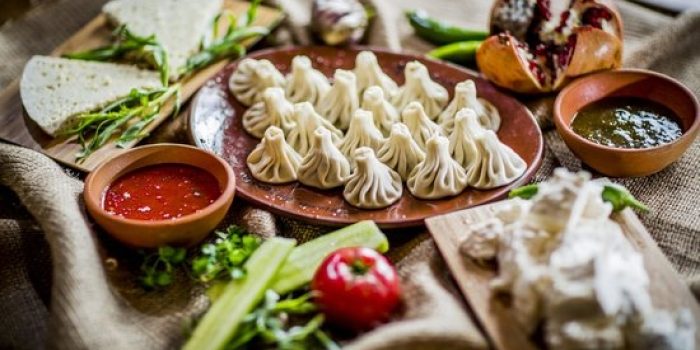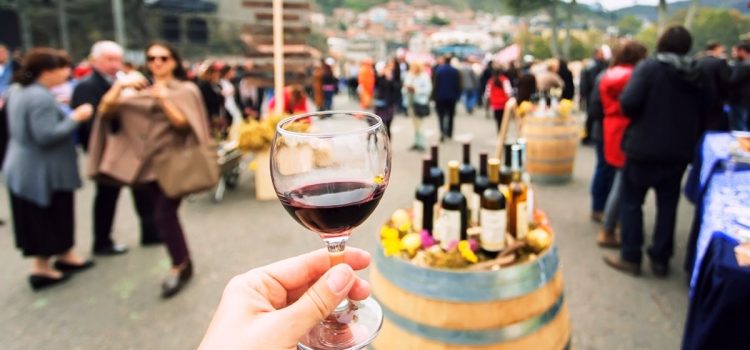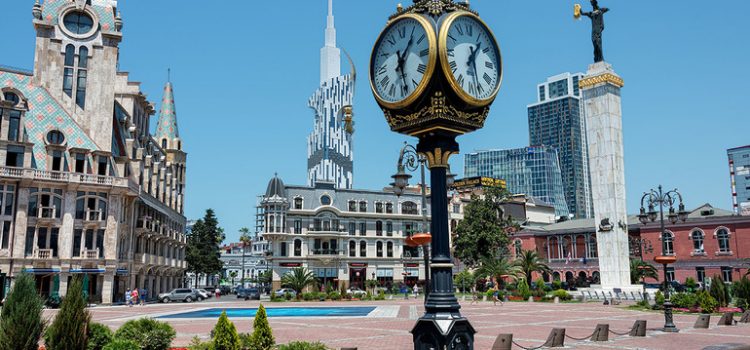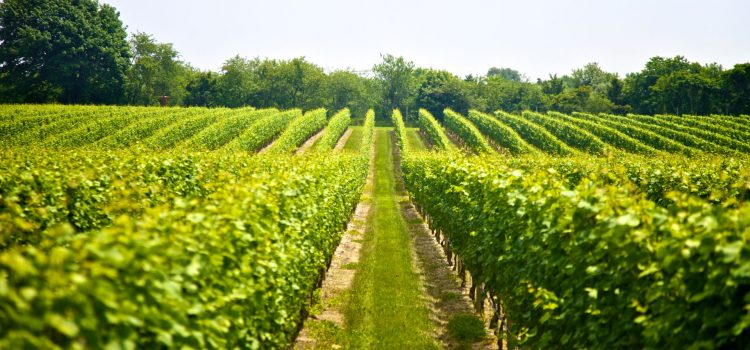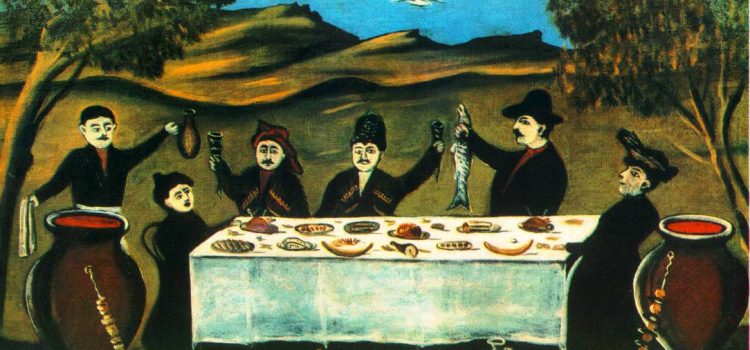Top 10 Must-Try Georgian Dishes
Georgians were ruled by Greeks, Romans, Iranians, Arabs, Byzantians, Mongolians, Ottomans, and Russians over the years. All of them brought their cuisine and ingredients into Georgia. Georgia managed to incorporate all the new ingredients and meals to create an identity for Georgian cuisine. When you eat Georgian food, you do not think it is Mongolian or Chinese but Georgian.
Here are the top 10 dishes to taste in Georgia:
1. Khachapuri
khachapuri is the most famous dish in Georgia. The pastry is traditionally topped with melted cheese, eggs and butter. There are different types of khachapuri but it is usually filled with Georgian Sulguni or Imeretian cheese. Three of the most common varieties include the Imeretian khachapuri, shaped into a circular form, Adjarian khachapuri, the open-faced version topped with butter and a raw egg on top and Megrelian Khachapuri shaped into a circular form and topped with melted cheese.
2. Kuchmachi
Kuchmachi is a traditional Georgian dish made of pork/chicken hearts, livers, gizzards mixed with walnuts and pomegranate.
3. Shkmeruli
Shkmeruli (roast chicken in garlic sauce) is a very old Rachan dish and it is one of the most popular dishes in Georgian restaurants. It has to be noted that the name derives from one of the villages in Racha region of Georgia, Shkmeri, which is said to be the place where this food has originated.
4.Khinkali
Georgian dumplings known as khinkali are considered to be one of the national dishes of the country. The dumplings are filled with meat and spices (mushrooms, potatoes, cheese can be used instead of meat), then traditionally twisted into a knot at the top. Regional differences influence the fillings and every part of Georgia has their distinctive variety. For example, in the mountainous regions, the most traditional filling is lamb.
The most frequent variety (often served in Georgian restaurants) throughout entire Georgia is a mixture of pork and beef.
5.Ostri
Ostri is hot and spicy beef with tomato sauce. The meat should be very tender when fully cooked.
6. Kubdari
Kubdari is a bread filled with beef, pork, or a combination of the two flavored with spices such as cumin, dill, coriander, blue fenugreek, red pepper, onions, garlic, and salt. The dough consists of flour, water, yeast, sugar, salt, and eggs. Interestingly, the meat used in this savory pie should be cut, not minced. Kubdari originates from Svaneti, one of the most beautiful mountainous and winter resorts in Georgia.
7. Chikhirtma
Chikhirtma is a famous Georgian soap. It is often believed that the soap is the best hangover cure. It consists of chicken pieces, onions, eggs, flour, vinegar, water, and seasonings such as salt, bay leaves, and coriander. It has a slightly sour flavor and a thick, creamy consistency. The soup is usually served hot, and it is recommended to garnish it with freshly chopped coriander.
8. Satsivi
Satsivi is a thick nut paste. It usually includes garlic, coriander, cinnamon, vinegar, and hot peppers. Satsivi is typically served as an accompaniment to meat dishes. However, it can also be served with vegetable dishes, alongside fish, or even with boiled eggs.
9. Elarji
Elarji is a specialty of the Georgian Samegrelo region (western Georgia), prepared as a thick porridge consisting of coarse cornmeal, cornflour, and sulguni cheese. The dish has an extremely thick texture, and it is very elastic. It is traditionally served hot and consumed with Georgian bazhe sauce, made with garlic, walnuts, and various spices.
10. Pkhali
Pkhali is a traditional Georgian dish of chopped and minced vegetables, made of cabbage, eggplant, spinach, beans, beets and combined with ground walnuts, vinegar, onions, garlic, and herbs.
Source: Georgianjournal.ge
Photo: Georgianjournal.ge
7.5 km long cable car opens connecting Kobi, Gudauri ski resorts
A 7.5 km long cable car between the ski resorts of Kobi and Gudauri opened earlier today, connecting the Stepantsminda region to Gudauri in just 15 minutes.
The cable car will serve to make both Kobi and Gudauri more functional winter resorts, offering easier transportation in the area.“Georgia will take its place on the global map as a country with the most successful ski resort. Number of tourists has increased by 500 percent in Gudari during last six years. This is a great success but not enough. This cable car is truly unic which will unify Gudauri and Kobi in one cluster. Outstanding Swiss and Austrian resorts have managed to achieve best results through realisation of the same strategy and I am sure that we are also getting closer to this level,” PM Bakhtadze said at the opening ceremony.
Kobi is a village in Stepantsminda, while Gudauri is a ski resort located on the south-facing plateau of the Greater Caucasus Mountain Range.
The distance between Kobi and Gudauri is 15.2km and by car you can cover this distance in about 22 minutes – but since landslides and heavy snow can force the car route through Jvari pass to shut in the winter, the new cable car will help the commuters or skiers transport back and forth anyway.
About 81 million GEL was allocated from the state budget to construct the Kobi-Gudauri cable car with the capacity of carrying 2,800 people in an hour.
Source: Agenda.ge
Wine on Mars? The World’s Oldest Wine-Making Country Wants to Make It Happen
The first human colonists on Mars will have to forgo many of the creature comforts of Earth — things like enjoying an ozone layer, for example, or opting out of rearing genetically engineered Martian babies. Fortunately, one essential earthly amenity these hardscrabble colonists may not have to give up is wine.
Georgia, a country with an 8,000-year-old viticulture tradition, is putting its top space and wine scientists to work figuring out how to grow grapes on Mars.
The project, named IX Millennium, ostensibly as a nod to Georgia’s ninth millennium making wine, will involve several phases of research into building an agricultural infrastructure on Mars. One critical step: identifying the grape varietals on Earth best equipped to withstand the harsh radiation, fearsome dust storms and severe temperature swings of the Red Planet. This research could help hydrate permanent settlements on Mars a soon as 2024 — the year when SpaceX founder Elon Musk intends to launch the first crewed mission there. (NASA hopes to follow in the 2030s.) [Mars InSight Photos: A Timeline to Landing on the Red Planet]
“If we’re going to live on Mars one day, Georgia needs to contribute,” Nikoloz Doborjginidze, founder of Georgia’s Space Research Agency and an adviser on the wine project, told The Washington Post. “Our ancestors brought wine to Earth, so we can do the same to Mars.” (The origins of wine are still debated, but Georgia holds a valid claim thanks to their recent discovery of an old wine-stained pot dated to 6000 B.C.)
The first wine on Mars
The new space wine project will kick off later this year with the installation of “vertical greenhouses” inside a hotel in the capital city of Tbilisi, according to Georgian news agency Agenda.ge. There, floor-to-ceiling pods of soil and seeds (including grapes, strawberries and arugula) will be left to grow under hydroponic lights with minimal human interference, simulating the possible conditions of a controlled agriculture pod on Mars.
In the meantime, Georgian wine experts are hard at work trying to figure out which grape varietals might best survive harsh Martian conditions. Over the next few years, researchers at Tbilisi’s Business Technology University plan to simulate a Martian environment in the laboratory, exposing soil samples to subzero conditions, high carbon monoxide levels and thin air meant to mimic the atmospheric pressure at “20,000 feet [6,000 meters] altitude on Earth,” The Washington Post reported.
These experiments likely will not bear fruit until at least 2022, but scientists already have a hunch that white wine will fare best on the Red Planet.
“Whites tend to be more resistant to viruses,” Levan Ujmajuridze, director of Georgia’s vineyard Laboratory, told The Washington Post. “So, I’d imagine they’ll do well against radiation, too. Their skin could reflect it.”
These experiments could well provide future Martians with grapevines — but the actual fermenting, bottling and aging would be up to them. Nobody knows exactly how fermenting grapes in microgravity will actually work yet, but NASA scientists think it’s possible.
The Georgia team’s boozy experiments aren’t the first foray into space agriculture. Astronauts aboard the International Space Station (ISS) have already begun growing salad crops in microgravity, while China’s recently deployed Chang’e-4 lander will attempt to grow potatoes and rockcress (a flowering plant similar to cabbage and mustard) on the moon.
The makers of Budweiser, meanwhile, have launched barley seeds into space three times in hopes of becoming “the first beer on Mars,” while a batch of Ardmore scotch whisky spent three years aboard the ISS from 2011 to 2014. That project showed Earthlings that even an old drop of the pure is apparently not immune to the ravages of microgravity; the scotch reportedly came home tasting of “antiseptic lozenges” and “rubbery smoke.”
Originally published on Live Science.
Source: www.Space.com
Why Georgian Qvevri are so efficient at making natural wine
Amber wines that are made in Qvevri are becoming increasingly well known in the UK – not only being imported from countries like Georgia and Armenia, but also through English winemakers who have decided to use Qvevri.
Raw, low-intervention, hand-made, artisanal, craft – when it comes to ‘naturally’ made wines, the vinicultural lexicon is as rich as it is imprecise. All of these descriptors are variously employed to distinguish wines made with minimal interference or the use of additives.
In Georgian winemaking, however, there is a clear and important defining feature and that is the Qvevri.
The name refers specifically to the large lemon-shaped terracotta pot that is buried in the ground up to its neck. The word literally means ‘that which is buried’ (not to be confused with ‘Amphora’ which are not).
Somewhat bizarrely the traditional way of spelling Qvevri is Kvevri but when Georgian is typed on a standard keyboard the key allocated to this ‘k’ is actually the ‘q’ key; Georgians therefore invariably spell the word with a ‘q’ in English, the Q spelling is increasingly being favoured by the Georgian wine industry because of its graphical resemblance to the oval-shaped Qvevri.
Crucially, the entire wine making process takes place within the Qvevri, from fermentation right through to maturation, with the fermenting grape juice often being left on the skins and even grape stems (the ‘mother’) to create wines of exceptional flavour, complexity and colour.
Notably, these include the amber wines that are made from indigenous grape varieties, Rkatsiteli, Kisi and Mtsvane that produce the characteristically dry but full-bodied, aromatic orange wines. Red wines, often made from the Saperavi grapes, are also produced in Qvevri, to produce wines that have an inky purple colour with intense aromatics and dense, supple texture.
Despite a recent revival in these methods, yields are low and currently account for less than 10 per cent of Georgia’s total wine production which adds to their cachet.
The Qvevri themselves are made today by less than a handful of surviving master craftsmen; Such is their importance to the history of winemaking that the United Nations placed them on the UNESCO Intangible Cultural Heritage list in 2014.
It takes on average three months to make one 2000 litre Qvevri (firing alone takes seven to eight days). A giant coil pot, its coils are added slowly and gradually to maintain the correct tension and strength needed to hold the shape and weight of the clay.
After firing, while still warm, it is coated on the inside with beeswax to clog the pores without sealing them completely, to allow some air to pass through during fermentation. Pure beeswax also has waterproofing and sterilizing properties that make the Qvevri more hygienic and easy to clean. A limestone paint or concrete outer coating is added to protect it during transportation.
Given Georgia’s reputation as the ‘Cradle of Wine’, it is impossible to ignore associations with creation, nurturing and birth. Like a giant egg, the vessel is sunken into the earth to prevent it from cracking or breaking from build-up of pressure during fermentation. There it will protect its embryonic wine for an average six-to-nine month gestation, safe from external threats such as potential earthquake and fluctuating temperatures.
Qvevri are used differently according to which part of Georgia you are in, often determined by the climate of the region. As the regions get hotter, the more skins and stems tend to be fermented with the grapes – if stems are left in the wine in the cooler regions it can produce wines that are far too ‘green’ and harsh.
Alcoholic fermentation begins naturally after a few days and continues for two to four weeks at which point the cap falls. The fermenting grapes are ‘punched down’ twice a day during fermentation. Once the cap falls, the red wines are generally removed from the lees, or ‘mother’ while the whites are left with her.
A stone lid is placed over the top of the Qvevri and malolactic fermentation begins spontaneously soon afterwards.
They are then left to mature for an average of six months during which time the unwanted lees, seeds and stalks fall into the nipple where they have limited contact with the wine.
After this time, the Qvevri is opened, to reveal the delicious, bright liquid. It is then put on its feet (either by pump, gravity or more low-tech ladles), and transferred into freshly cleaned Qvevri, barrels or other storage vessels until it is ready for bottling. At the end of the cycle, the empty Qvevri is scrubbed thoroughly from the inside with a brush made from St John’s Wort to ensure it is sterile before it is filled again.
There are varied and often opposing views on the use of additives, including cultured yeasts, enzymes and sulphates. Some growers eschew them entirely while others seem to adopt a more discretionary approach. Either is the prerogative of the winemaker and subject to ever-changing new developments, consumer demands and legislation. In the meantime, it seems that the essential art of Qvevri winemaking is likely to remain as it has for the past 8000 years.
Source: The-buyer.net
NY Times Includes Batumi in 52 Places to Go in 2019
The New York Times published a list of ‘52 Places to Go in 2019,’ which includes Georgia’s Black Sea coastal city Batumi.
The article reads that Tbilisi, Georgia’s capital, has been flooded with tourists over the past decade, adding Batumi, a “hushed seaside city where verdant mountains slope down to the Black Sea’s smooth stone beaches,” offers a different experience.
“Already a popular escape for Russians, Iranians, Turks and Israelis, the city is preparing itself for its inevitable discovery by the rest of the world: new hotels — including the Le Meridien Batumi and a Batumi installment of the design-centric boutique Rooms Hotel line — are rising, and a cable car will swing straight to the coast from the hilltop Batumi Botanical Garden,” the article reads.
Top 10 destinations of the list are:
- Puerto Rico
- Hampi
- Santa Barbara
- Panama
- Munich
- Eliat
- Setouchi Islands
- Aalborg
- The Azores
- Ontario Ice Caves
Source:Georgiatoday.ge
Georgia marks national flag day
The current national flag was officially introduced on 14 January 2004.
The flag was used by the Georgian patriotic movement following the country’s independence from the Soviet Union in 1991.
By the late 1990s, the design had become widely known as ‘the Georgian historical national flag’ as vexillologists had pointed out the red-on-white Jerusalem cross shown as the flag of Tbilisi in a 14th-century map by Domenico and Francesco Pizzigano, the 14th century Venetian cartographers.
A majority of Georgians, including the Georgian church, supported the restoration of the flag that took place in 2004.
The winning entry replaced an earlier, three-colour flag first adopted for the 1918-1921 First Democratic Republic of Georgia before it was restored in 1990, ahead of Georgia’s proclamation of independence from the Soviet Union.
Drawn by painter Iakob Nikoladze, the design was selected for the original Republic that became independent from Imperial Russia following the 1917 Russian Revolution.
The State Council of Heraldry called upon Georgian citizens today to set and raise the national flag on their home windows, balconies, fences, roofs and cars to honour Georgian statehood and independence, national and individual freedoms.
Georgian President Salome Zurabishvili hosted a special event at her residency today and stated that the Georgian flag “symbolises the independence of the country, its freedom and everything which is valuable for us”.
The day of the national flag was first marked in 2012.
Source: Agenda.ge
Forbes Features “Unique” Georgian Wines
Forbes published an article this week by contributor Lana Bortolot titled ”Why Georgian wines are Among the Most Unique on the Planet”.
Bortolot is a wine, food, and travel reporter who holds the Advanced Wine & Spirits Education Trust certificate and has covered wine regions in more than 16 countries.
In the article, Bortolot explores Georgian wine culture, the role of wine in modern Georgian society, and the technical side of Georgian wine. The piece is peppered with quotes from Georgian wine lovers:
“Even where we think a culture like France or Italy is so wine-centric, Georgians just take it to a whole different level—much deeper than what we’re exposed,” – Taylor Parsons
“There’s something very particular about how Georgians love wine,” he said. “It’s a little eccentric but then you start looking into it and once you do, you’re truly amazed—it’s such an integral part of the culture and everyday life.” – Noel Brockett
“One of the most important things about Georgian wines is that it’s a window into a culture that most of us as Westerners simply don’t have,” – Simon J. Woolf
Bortolot goes on to focus on orange or amber wines, a style growing in popularity worldwide that has long been part of Georgia’s tradition. She also recounts a legend, which said that, in ancient times, “soldiers wove a piece of grapevine into the chain mail protecting their chests, so when they died in battle, a vine sprouted not just from their bodies, but their hearts.”
The article introduces readers to several Georgian wine makers – locals and expats, high end factories and garage operations – celebrating the varied, inclusive culture of Georgian wine.
The article ends with a wine sampler. Bortolot recommends Kisi, Mtsvane, Rkatsiteli, Saperavi, and Tsinandali for beginners.
By Samantha Guthrie, Source: Georgiatoday.ge
Arles Museum to Host the Exhibition of Niko Pirosmani Paintings
After famous Albertina Museum in Vienna, ‘Niko Pirosmani – A Wanderer between Worlds’ will continue its journey through other European countries.
The next ‘stop’ for the exhibition will be Arles Museum of Modern Art in the South of France. The works of the self-taught primitivist painter, who represents a unique figure of Georgian art will be displayed alongside the paintings of the prominent Dutch impressionist Vincent van Gogh, who lived in Arles for a time.
The exhibition is scheduled for March 2019 and will likely last until summer. It was stated by the Georgian National Museum that negotiations are ongoing about the details of the organization of the exposition. The exhibition is prepared by the Georgian National Museum (GNM) network and the Vincent van Gogh Foundation in Arles.
29 works of Pirsomani, currently being displayed at the Albertina Museum, will be showcased in Arles.
The opportunity to exhibit Pirosmani’s paintings at Albertina is considered an unprecedented success in promoting the country and its culture. General Director of the Georgian National Museum David Lordkipanidze told Imedi TV, the given exhibition had record-breaking viewer numbers.
After Austria, the French audience will also be presented a chance to observe the paintings of Pirosmani and explore the Georgian avant-garde.
By Ketevan Kvaratskheliya, Source: Georgiatoday.ge
Image source: imedinews.ge
Georgian Food Named as Cuisine of the Year by Af&co
Af&Co has named Georgian food as Cuisine of the Year and Khachapuri as its dish of the year in its 2019 Trends Report.
Based in San Francisco, af&co is a leading restaurant and hospitality consulting firm. Their report identifies the hottest key trends in restaurants, food and beverage, and hospitality marketing.
The Ajarian dish Khachapuri has been awarded the title of Dish of the Year thanks to its tasty combination of cheese and egg, and its instagramability. It’s already being served in some restaurants in the US, including Supra in Washington DC, Cheeseboat in Brooklyn and Barbounia in New York.
The Trends Report was the eleventh edition published by af&co. Founder Andrew Freeman noted that “the hospitality industry is leading the charge in creating the world we want to live in. Restaurants and hotels are gathering places for people to connect, creating the perfect grounds for people to come together, get personal, and embrace forward-thinking ideas.”
By Amy Jones, Source: Georgiatoday.ge
Photo source: reddit.com
Tbilisi gets ready to celebrate Christmas and New Year
Winter illuminations for Christmas and New Year are finally installed in Tbilisi, the capital of Georgia. Tbilisi’s main Christmas Tree was officially lit up on the First Republic Square on the 22nd of December. The event was accompanied by Christmas songs and performances. The prime Minister Mamuka Bakhtadze and the Tbilisi Mayor Kakha Kaladze participated in the event and wished the gathered people Happy Christmas and New Year.
Festive decorations were put on Rustaveli, Tamarashvili and Cholokashvili Avenues as well as Kostava,Baratashvili and Melikishvili Streets, which has made night strolls in Tbilisi even more enjoyable.

